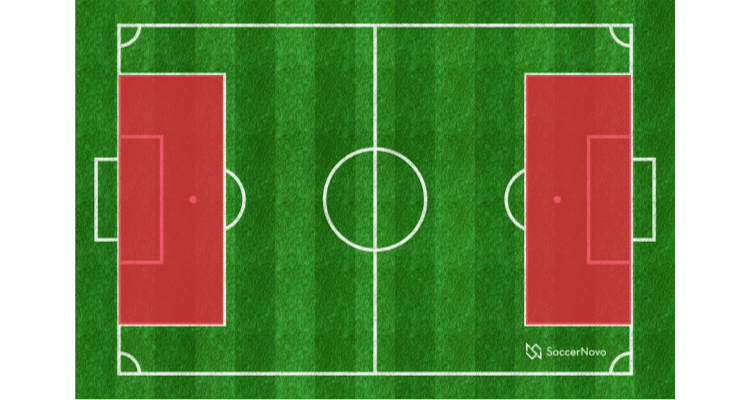The 18-Yard Box: Soccer’s Most High-Stakes Area
The 18-yard box in soccer is the rectangular area in front of each goal where goalkeepers can use their hands and special rules apply, including penalties for fouls committed within this space.
TL;DR:
What Exactly Is “The 18” and Why Does It Matter?
When soccer players and coaches talk about “the 18,” they’re referring to the rectangular area extending 18 yards from the goal line and spanning 44 yards in width.

This critical space, marked with white lines on every standard soccer field, serves as more than just a geometric shape on grass – it’s where many games are won and lost.
I’ve always thought the penalty area is soccer’s equivalent to the red zone in American football – it’s where tension rises and scoring opportunities become most dangerous.
Rules That Make The 18 Special
The penalty area comes with a unique set of rules that make it distinct from the rest of the field:
Goalkeeper’s Domain
The 18-yard box is the only place where goalkeepers are permitted to use their hands, though even they face restrictions:
- They cannot hold the ball for more than six seconds
- They cannot pick up deliberate back-passes from teammates’ feet
- They must stay within the box when taking goal kicks
These limitations help balance the goalkeeper’s hand advantage and maintain the flow of play.
Penalty Kick Territory
Perhaps the most dramatic aspect of the penalty area is that fouls committed by defenders inside it result in penalty kicks – one-on-one opportunities from the 12-yard mark that often decide games.

This creates enormous pressure on defenders to be extremely careful with their challenges inside “the 18.”
In my experience, no moment in soccer creates more nervous energy than a PK in the final minutes of a close match.
Historical Evolution
The penalty area wasn’t always part of soccer.
Before its introduction in 1902, goalkeepers could handle the ball anywhere on the field (imagine that chaos!). The original design was actually a 20-yard semicircle, which later evolved into the rectangular shape we know today by 1937.
The rules governing this area continue to evolve. In 1997, the back-pass rule prevented goalkeepers from picking up passes from teammates, encouraging more attacking play.
More recently, in 2019, handball rules were clarified to state that goals cannot be scored if the ball touches an attacker’s hand or arm, even accidentally.
Strategic Importance
Beyond its technical rules, the 18-yard box serves as a crucial tactical reference point. Teams might play a “high line” at the top of the box to catch opponents offside, while attacking players carefully time their runs to penetrate this area without triggering the offside rule.
During set pieces like corner kicks and free kicks, the penalty area becomes a battlefield of positioning as attackers and defenders jostle for advantage.
Understanding The 18 Makes You Smarter
Next time you’re watching a game and hear commentators talk about “the 18,” you’ll know exactly what they mean and why so much attention is focused on this crucial rectangular space.
From goalkeeper restrictions to penalty decisions, understanding the 18-yard box helps you appreciate the game’s finer points and most dramatic moments.

Written By: SoccerNovo
SoccerNovo is an independent youth soccer media brand built to help parents, players, and coaches better understand the game and the pathways available in U.S. soccer. Our mission is to make youth soccer simpler, clearer, and more accessible for everyone involved in it.
Let’s connect




